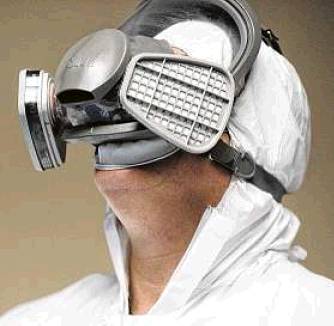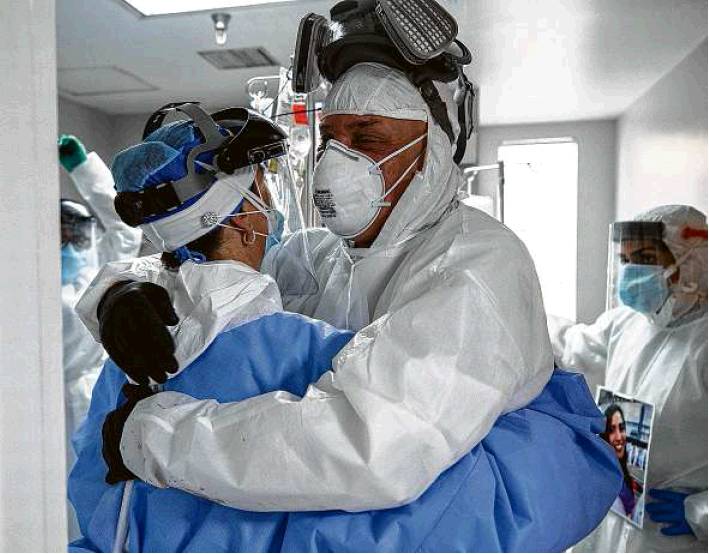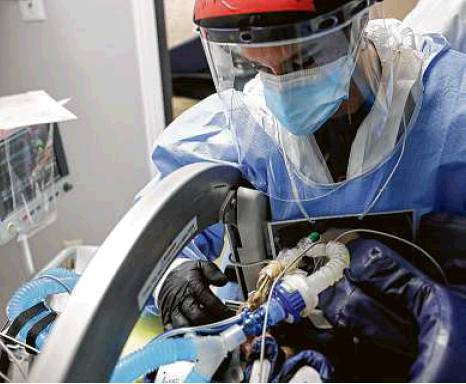CORONAVIRUS OUTBREAK
Abbott ‘concerned but not alarmed’ as cases surge
SPIKE: New record for hospitalizations set in Texas in four of the last five days
By Jenny Deam, Todd Ackerman and Matt Dempsey STAFF WRITERS
The 64-year-old man staggered into United Memorial Medical Center’s emergency room on Monday, gravely ill. It is unknown when he became infected, though the doctors believe it was recent. An X-ray showed spidery webs of COVID-19, the disease caused by the novel coronavirus, coating both lungs, making them all but useless.
By Thursday morning, his kidneys were failing. The staff was looking for next of kin.
Death, it seemed, was moving from possible to likely in Room 409 of the hospital’s newly expanded COVID-19 unit.
“I have a bad feeling about this,” said Dr. Joseph Varon, a pulmonologist and chief of staff at the small community hospital in Acres Homes, one of Houston’s hardest hit areas. He had not yet lost a patient to the virus, but those arriving these days — second wavers, he calls them — are sicker than those who came before. And all have been stricken in the weeks since Texas loosened statewide precautions and society began to assume the worst was over.
What is happening at United Memorial is playing out in hospitals across Texas. On Friday, the number of confirmed COVID-19 patients hospitalized climbed to 2,166, up more than 150 from just the day before. In fact, Texas has set a new record for overall COVID-19 hospitalizations in four of the last five days, according to the Department of State Health Services.
That kind of acceleration is worrying health officials. In the Houston region during the past two weeks, the rolling average of confirmed or suspected COVID-19 patients in ICU beds has jumped 20 percent — from 274 on May 27 to 330 on Wednesday, according to the Southeast Texas Regional Advisory Council, which coordinates the region’s emergency response to disasters.
And the number of people testing positive is also on the rise. The rolling average of new cases per day in Texas reached 1,716 on Thursday, almost doubling from May 27. In Harris County, the number of new cases reached 323 on Thursday, up from 207 on May 27, the SETRAC data showed.
While some of those increases can be tied to an uptick in testing, it cannot be the whole explanation, said Dr. Alison Haddock, an emergency room physician at Ben Taub, Houston’s largest public hospital, and an assistant professor of emergency medicine at Baylor College of Medicine.
Not only are the number of positive tests going up, so, too, is the rate of positives, which is perhaps more significant, Haddock said. On May 27, the statewide rate of positives per test given was 4.3 percent. By Thursday, it had risen to more than 7 percent. That means if 100 people were tested last month, only about 4 were positive. Now, it is at least 7.
Taken as a whole, Haddock said, there is little escaping that “there are more COVID cases in Houston than there were three weeks ago.”
While the increases are concerning, hospitals across the state are also ramping up the number of beds and ventilators available.
More than 7,200 ventilators are available, an increase of more than 1,700 from Thursday, according to DSHS. This is the most ventilators that have been available since the first coronavirus cases were diagnosed in Texas.
There were nearly 18,000 beds available statewide, an increase of about 4,700 from Thursday and the greatest amount since mid-May, according to DSHS.
‘I think we opened too early’
It’s an I-told-you-so most doctors wish had never come true.
As April waned, the political winds began to favor a rapid reopening even as health officials warned that later was better than sooner.
Still, Gov. Greg Abbott began a phased reopening of the state May 1, one of the earliest in the nation. By Memorial Day weekend, throngs of people packed beaches, parks and bars after being cooped up for months.
Abbott said this week he was “concerned but not alarmed” by the spike in cases following reopening, saying it was expected.
Varon, the doctor at United Memorial, understands the political tightrope. “I know we had to get the economy going again,” he said, “but I think we opened too early, or at least in a way that let people think everything is OK. To have a healthy economy, you have to have a healthy population.”
“I have admitted more people in the last two weeks than in the previous 10,” he said Thursday. Initially, his hospital had 20 beds for COVID-19 patients, but recently a second unit had to be opened. Capacity is now 46, which could be stretched to 58. On Thursday he had 34 COVID-19 patients, all of them critically ill.
A dozen miles away a similar picture is emerging in Houston’s safety-net hospitals.
On Friday as on Wednesday, the number of COVID-19 cases hit its high-water mark of 71 at Harris Health System, up from around 50 three weeks ago. At Lyndon B. Johnson Hospital’s intensive care unit, occupancy rate Friday was 104 percent; Ben Taub’s was 93 percent, according to officials.
“Busy, busy, busy,” Dr. Esmaeil Porsa, CEO of the public health system, said Friday. “It’s scary to think where we’re going to be at the end of the month.”
Porsa predicts an even greater spike in the aftermath of tens of thousands of people who recently took to the streets in Black Lives Matter protests and gathered to pay tribute at the funeral for George Floyd. “I don’t know what to expect,” he said. “Obviously we don’t have unlimited capacity.”
It is not lost on the health executive that only weeks ago he was congratulating the region for its compliance with social distancing and other precautions. But that was then.
“It’s like we’re trying to snatch defeat out of the jaws of victory,” Porsa said.
Hanging on
“You’re doing a really great job, buddy. Hang in there,” Tanna In-graham, head nurse in the COVID-19 unit at United Memorial, murmured softly to the heavily sedated patient, immobilized in his hospital bed.
Ingraham was sure he can hear her. “Hearing is the last thing to go,” she said.
Varon and the crew of three others worked against the clock Thursday afternoon to push a needle into a vein so a catheter could be inserted to start dialysis and boost kidney function.
But the virus had so wrecked his body that his veins were blocked. A healthy amount of oxygen in the blood is near 100 percent. Too low and a patient will die. But without kidney function he would also die. Varon had to try.
The blood oxygen levels began to drop by the second. 90. 83. 73.
68.
Varon tried to find a willing vein in the man’s groin. He failed. He tried again and failed again. A third try, another blockage. But then, suddenly, it worked. Varon raised his fists to the sky. The patient’s oxygen levels had somehow stabilized. They were out of the woods.
“Not today,” he said, mocking death. “Not on my watch.”
On Friday, against the odds, his patient was still alive.
In the meantime, four new patients with COVID-19 were admitted.
Jordan Rubio and Jeremy
Blackman contributed to this report. jenny.deam@chron.com todd.ackerman@chron.com matt.dempsey@chron.com




